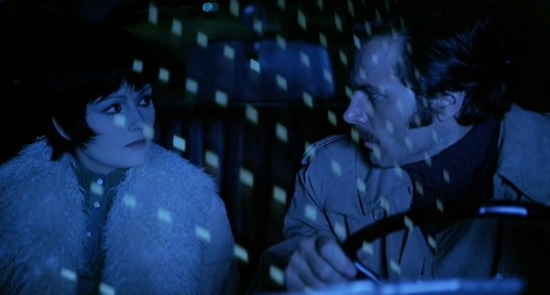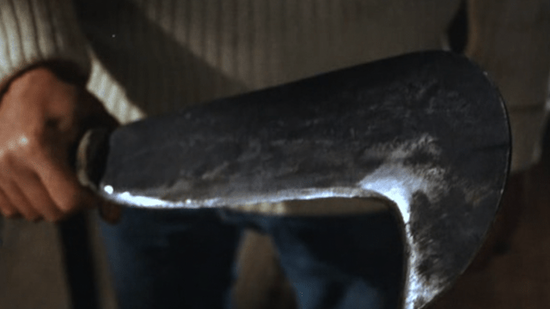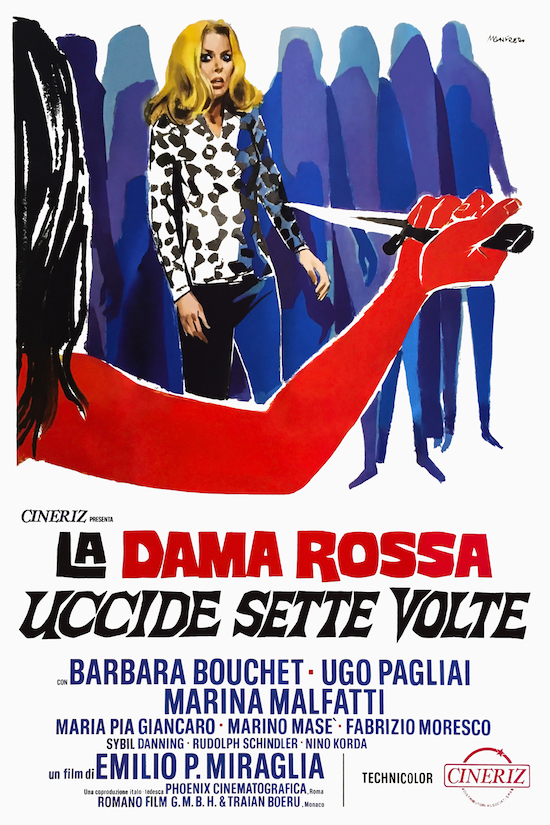Piercing is the strange, slow-build, high-tension second feature by New York-born director Nicolas Pesce. Based on the novel by Ryu Murakami, it follows a married man (Christopher Abbot) who checks into a hotel with an almost business-like plan to solicit and murder a prostitute. When Mia Wasikowska’s highly strung call girl Jackie turns up, he soon finds himself with rather more than he bargained for.
Pesce’s debut from 2016, The Eyes of My Mother featured an original score by newcomer Ariel Loh. But for Piercing he decided to try something different. "We did one pass of an original score for the movie," he told me via Skype. "It was a great score, it was great music, and it definitely worked, but there’s something about the quality of old music in general, but particularly this stuff –" By this stuff, he means the vintage Italian horror soundtracks that have been raided, repurposed and recontextualised to create a whole new soundtrack for Piercing.
Stuffed full of classic music by the likes of Goblin, Bruno Nicolai, and Stelvio Cipriani, Piercing is a love song to the highly aestheticised, baroquely blood-spattered Italian thrillers of the 1970s, inspired by the yellow-jacketed pulp paperbacks of the post-war era. We caught up with the director to ask him about his ten all-time favourite gialli.
The Bird With the Crystal Plumage (1970, Dario Argento)

The Bird With the Crystal Plumage was my entry point into giallo. What I love about it is the art, the furniture, the design – they all play a role in, not only the aesthetic of the movie, but also in the narrative. It affects the characters, even down to the actors physically in the spaces. That movie realy showed me how much visual design can affect more than just the aesthetic of the movie in a really powerful way. People often feel like if you push the aesthetic too far it can take you out of the movie. But a through line in all gialli movies is that they really find a way to work it into everything. We did it with Piercing too. The main character is an architect. Their clothes say a lot about them. The spaces they inhabit say a lot about them. So Bird With a Crystal Plumage was very much a big inspiration.
Deep Red (1975, Dario Argento)

The band Goblin did a lot of Argento’s scores and Deep Red is one of their best. But the thing that’s awesome about Deep Red is he didn’t do all the colourful lighting like with Suspiria but he did bring a lot of colour in through the set design and the costumes.Seeing what Argento did with Deep Red, where he made it bright and colourful and still used this dark film noir lighting, bringing the colour in through the sets and the curtains and all that stuff; if you look at Piercing, there’s a very specific colour palette in each location and it gets more and more vibrant as it goes. It starts off beige in Reed’s apartment. Everything is very monotone. We get to to the hotel and it’s mostly brown but you get pops of yellow and blue. And then once we get to Jackie’s apartment every surface is red. I got a lot of that design stuff from Deep Red
Tenebrae (1982, Dario Argento)

My favourite Argento movie is Tenebrae. The theme from Tenebrae is in the end credits of Piercing. It’s my favourite Goblin score. It’s probably the most disco of them. To me, there’s something about Tenebrae that’s so quintessentially giallo. It’s the classic set up of the crime writer who’s crimes are happening in real life and now he needs to help the police solve it. And I think that it’s got so many elements that are so quintessentially giallo, from the villain in the black gloves to the whole cat and mouse whodunnit of it all. It’s got a vibe to it, where it is arty but it’s still kind of just a slasher and it’s awesome that it finds a way to ride those two at the same time and then you get this psychosexual Brian De Palma thing in the middle. There’s just something really magical about Tenebrae that I love a lot.
The Fifth Cord (1971, Luigi Bazzoni)

I love this director Luigi Bazzoni who never gets any love when people talk about giallo movies. And Luigi Bazzoni made this movie called The Fifth Cord. It’s probably his most famous and the look of it is incredible. It’s so graphic. It feels like a film noir movie with the horizontal blinds and the shadows, and the architecture is so stunning. But there’s something about the way he shot Italy that feels almost like Blade Runner, in a weird way. And it comes from the look of the movie. He found a way of making Italy feel like a different country, like a place out of time. There’s something almost sci-fi about the look of it. With Piercing, there was very much this attention to making the world feel sort of unrealistic, or at least out of place and time. How do we make it feel like this isn’t a place that you know or might have been to but maybe you could have done. There’s something about the way Bazzoni handles the worlds of his movies that was really helpful in that regard.
A Bay of Blood (1971, Mario Bava)

Mario Bava’s Bay of Blood has some of the best depictions of violence. He’s really in-your-face with the violence but he does it in a way that is stylised enough to take it to another level. Although he’s putting all that violence on screen, he’s doing it in such a stylish way that it becomes a commentary on violence in movies. If you remade any of Bava’s movies… I mean, Eli Roth so clearly loves Bava but [in his hands] it becomes torture porn. Bava had an artistic flare to it. There are scenes in Piercing where we wanted to be aggressive and in-your-face with some of the violence but to do it in a way that was a little sexier, a little more cinematic, and I got a lot of that from Bava.
The Red Queen Kills Seven Times (1972, Emilio Miraglia)

Red Queen Kills Seven Times is a much-under seen movie. It’s the score that comprises the majority of piercing. It’s composed by Bruno Nicolai. I love how Tarantino uses music in his movies, but something that I’ve found, when you do a total hodgepodge of found music, is that you lose that John Williams thing of having a musical motif that you hear throughout the movie. It comes back and feels like a theme. When you just totally license the whole movie, it gets hard to do that. We knew that we wanted to have a bit of that old Hollywood feel where you have this recurring theme. So we knew that we needed one score to bridge the whole movie. Then it became a challenge. You can’t use one of the Goblin scores because it’s too recognisable. You can use those tracks sparingly but if the whole movie is that, it’s going to feel like the movie is another movie. So it needs to be something obscure enough that not everyone watching Piercing would know it and have an emotional reaction to it. But it had to be good enough that the score was… awesome. We felt like we were trying on clothes, trying on a lot of different scores. And we got Red Queen, it just felt right. It did the tension, it did the scary stuff, and it balanced all the different tones that we were gonna do with the other stuff.
Camille 2000 (1969, Radley Metzger)

One of the funny things about giallo movies is that in a lot of cases, the scores are better than the movies are. In the case of Camille 2000, the movie is basically a softcore porno and the score is a sixty or seventy piece orchestra. These scores so big, so orchestral – but weird. You would never get anyone to pay for that size of a score with that many musicians today. On the scale of a movie like Piercing, the way that we can achieve that scale is with computers and layering but then that digital process starts taking away the intention and feel of seventy people in a room all playing together. So there was something that just kept bringing us back. You can tell from watching the movie how much I love movies. It’s fun to get to share this stuff. I always admire hip hop artists getting to take the music that they love and do their thing on top of it. There’s something about it that feels like that. I can’t take images directly. I can pay homage with my own images. But I can take the music and re-contextualise it and tip my hat to the movies that I love and the movies that inspired it.
Tentacles (1977, Ovidio G. Assonitis)

Not a classic down-the-road giallo movie, but there’s this movie Tentacles. Stelvio Cipriani did the soundtrack. Cipriani is one of these guys who came from spaghetti westerns. Tentacles is actually an American movie but with a ton of Italian crew. It’s a weird John Huston movie that’s a bad rip-off of Jaws, but the music is incredible. It’s what our opening credits in Piercing comes from. And if you check out the soundtrack, the titles of songs are incredible. The track we use is called ‘Too Risky a Day for a Regatta’. They’re just great, great titles.
All the Colours of the Dark (1972, Sergio Martino)

This film is directed by Sergio Martino. For me, the thing about it is the look and the aesthetic, how he uses reflections and design elements to complicate shots and play with perspectives. Piercing is so much a movie about perspectives and who thinks what is going on when. There’s a lot of mirror shots – and a lot of our mirror shots have a lot of mirrors in the shot. I definitely stole that from Martino.
Zombi 2 (1979, Lucio Fulci

This is not a direct line to Piercing but I’ve got to give a nod to [Lucio] Fulci and Zombie, which is such a bonkers movie. Fulci had an energy to him that feels like he was tapped into something very, very weird. And it came out on screen. How he played with dream logic and surrealism within horror was really, really cool.
Piercing is in UK cinemas now. It is also available to own on digital HD


